Context
Municipal waste comprises waste generated by households and waste from other sources that is similar in nature and composition to household waste, such as from small commercial businesses and public institutions (EU, 2018). Municipal waste accounts for 27% of total waste, excluding major mineral wastes, generated in the EU (Eurostat, 2022a; 2022b). As it is a complex mix of materials — recyclable and non-recyclable, hazardous and non-hazardous — it requires good management, which is influenced by multiple socio-economic and political drivers.
EU waste policy is guided by a five-step waste hierarchy (Figure 1) introduced by the Waste Framework Directive (EU, 2018). This hierarchy prioritises waste prevention, followed by reuse, recycling and other forms of recovery, with disposal (including landfilling) being the last resort.
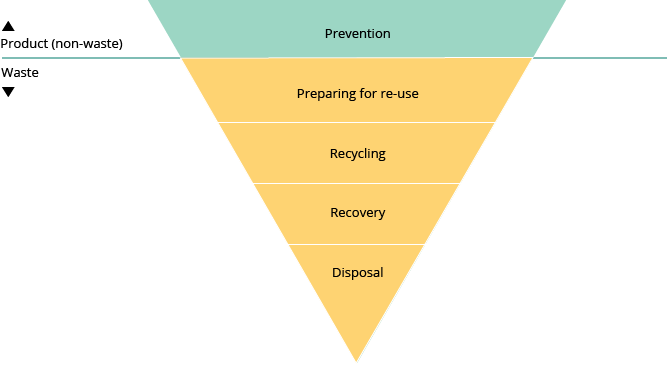
Source: EU (2018)
Despite the improvements in waste management driven by various EU waste policies and targets, the amount of neither total nor residual (non-recycled) municipal waste generated has decreased since 2015. Hence, new policies have been developed and are now being implemented to promote waste management actions at higher levels of the waste hierarchy. These include the European Green Deal (EC, 2019), the 2020 circular economy action plan (EC, 2020) and the Waste Framework Directive (EU, 2018).
For 2030, two targets have been set for municipal waste:
- At least 60% of municipal waste generated should be prepared for reuse or recycled (Waste Framework Directive) — a binding obligation that has to be met by each EU Member State individually.
- Residual (non-recycled) municipal waste should be reduced by half (circular economy action plan and zero pollution action plan) — a non-binding commitment that should be achieved at EU level.
While the first target is relative (i.e. to recycle a defined share of municipal waste), the second is an absolute target (i.e. to reduce residual waste by a defined amount), and so the two are linked through the amounts of municipal waste generated.
Definitions
- Residual waste (a): waste that was neither recycled nor reused, i.e. waste material not collected separately for recycling or composting/digestion, and residues from sorting processes (Figure 2). Residual municipal waste is either incinerated or landfilled, two options that pose environmental threats, destroy resources and entail the extraction of new materials, stalling the circularity of material flows.
- Recycling (b): any recovery operation in which waste materials are reprocessed into products, materials or substances, fit for the original purpose or not.
- Preparing for reuse (b): checking, cleaning or repair operations, by which products or their respective parts are prepared to be reused, without requiring any other pre-processing;
- Waste prevention (b): actions taken before a substance, material or product has become waste, with the aim of reducing the quantity of waste, the harmful substances associated with waste and the unfavourable impacts on the environment and human health.
(a) Definition from the EEA; no EU legal definition available.
(b) Definition from EU, 2018.
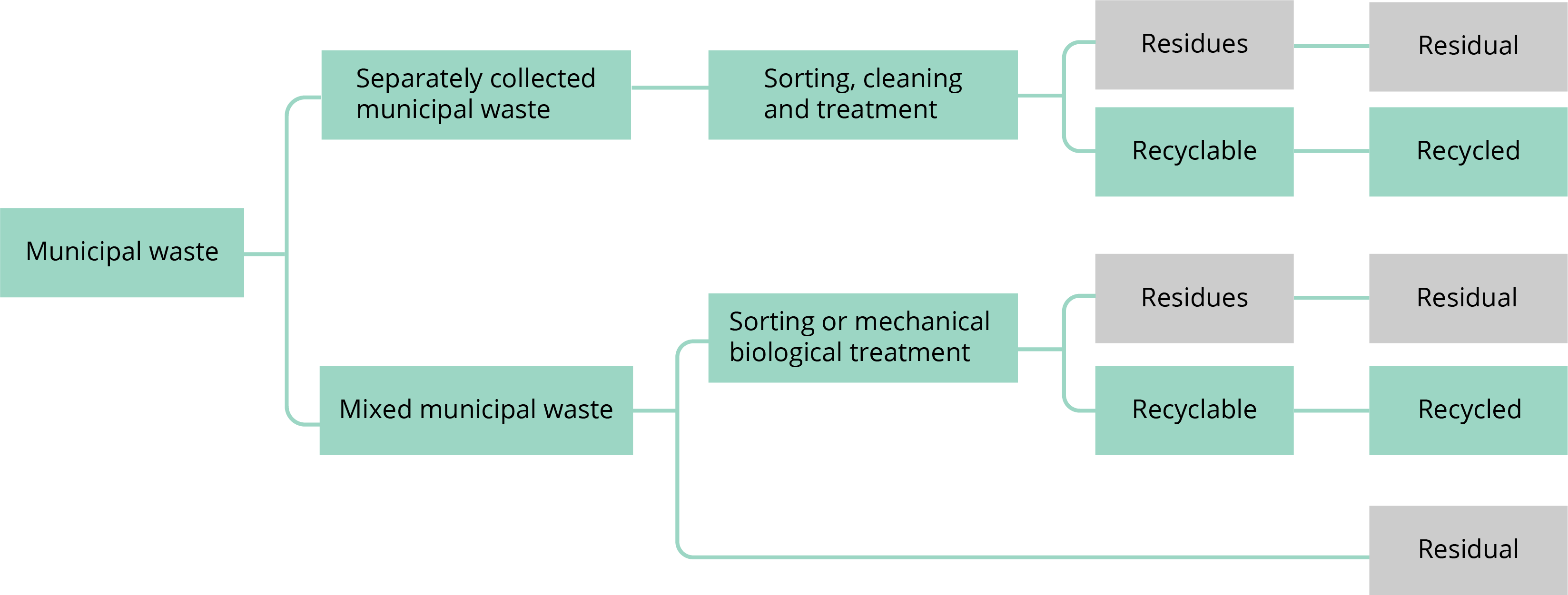
How has the amount of residual municipal waste changed over time?
Since 2004, the amount of residual municipal waste has decreased by 16% (Figure 3), reaching a plateau in 2016 and amounting to 113 million tonnes in 2020. If 2020 is used as the reference year [1], to decline by half the amount, residual municipal waste must decrease to a maximum of 56.5 million tonnes within a decade. This is likely to be particularly challenging considering that the absolute amount of residual waste has remained stable for the last 5 years even though the recycling rate increased from 45% in 2015 to 48% in 2020. In other words, improvements in recycling were offset by increases in waste generation.
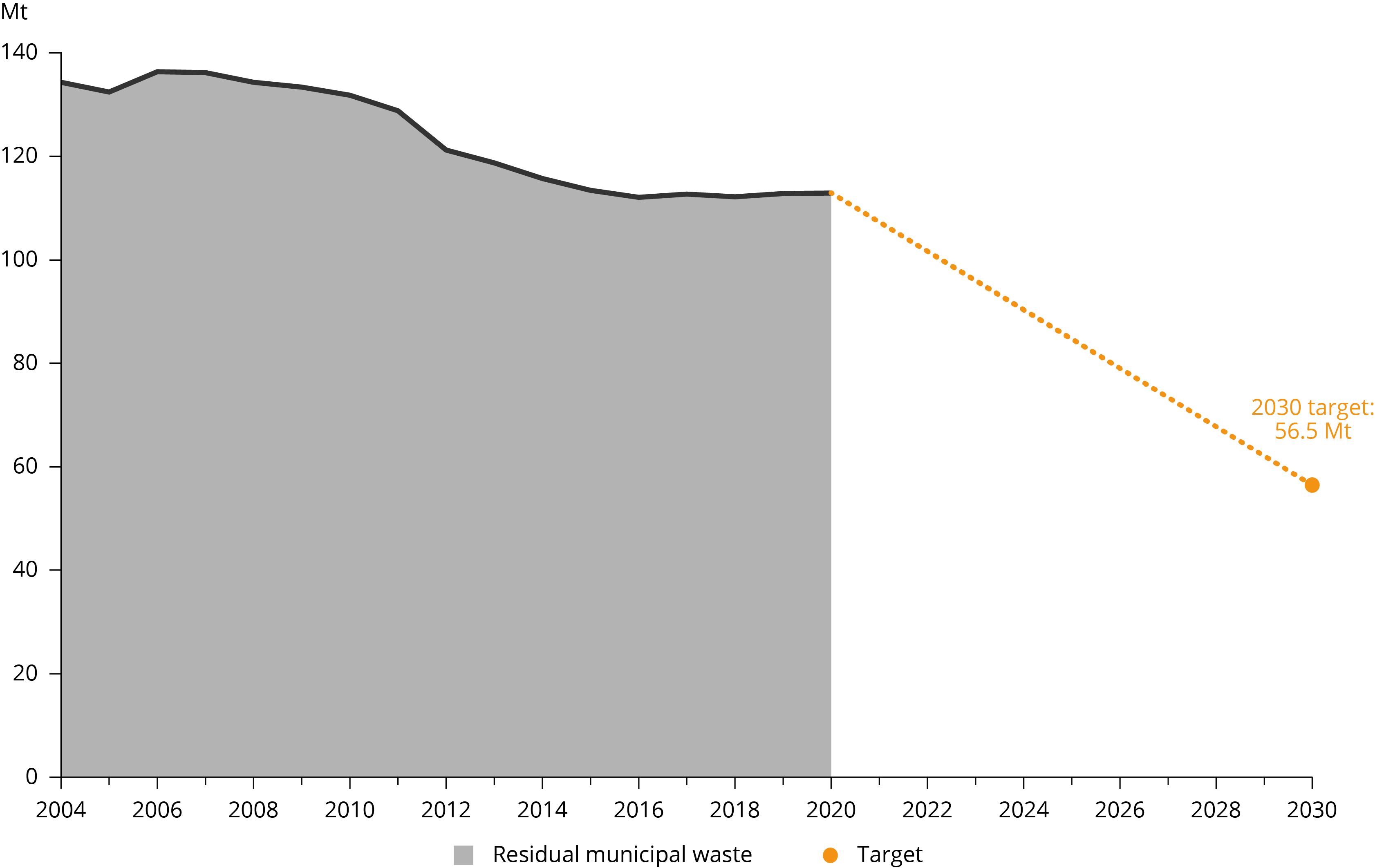
Note: Here, residual municipal waste is calculated as the sum of landfilled and incinerated waste, which corresponds to all treated municipal waste minus recycled municipal waste (including both material recycling, and composting and digestion).
Source: EEA calculation based on Eurostat (2022b).
More Info...
How will municipal waste generation change?
In a recent study for the European Commission (European Commission et al., 2022), scenarios for the generation of total municipal waste predict that the amounts will remain relatively stable until 2030 (Figure 4), with one projection suggesting a slight decrease (-3.6%) and one a slight increase (+3.7%), when compared with 2018 values.
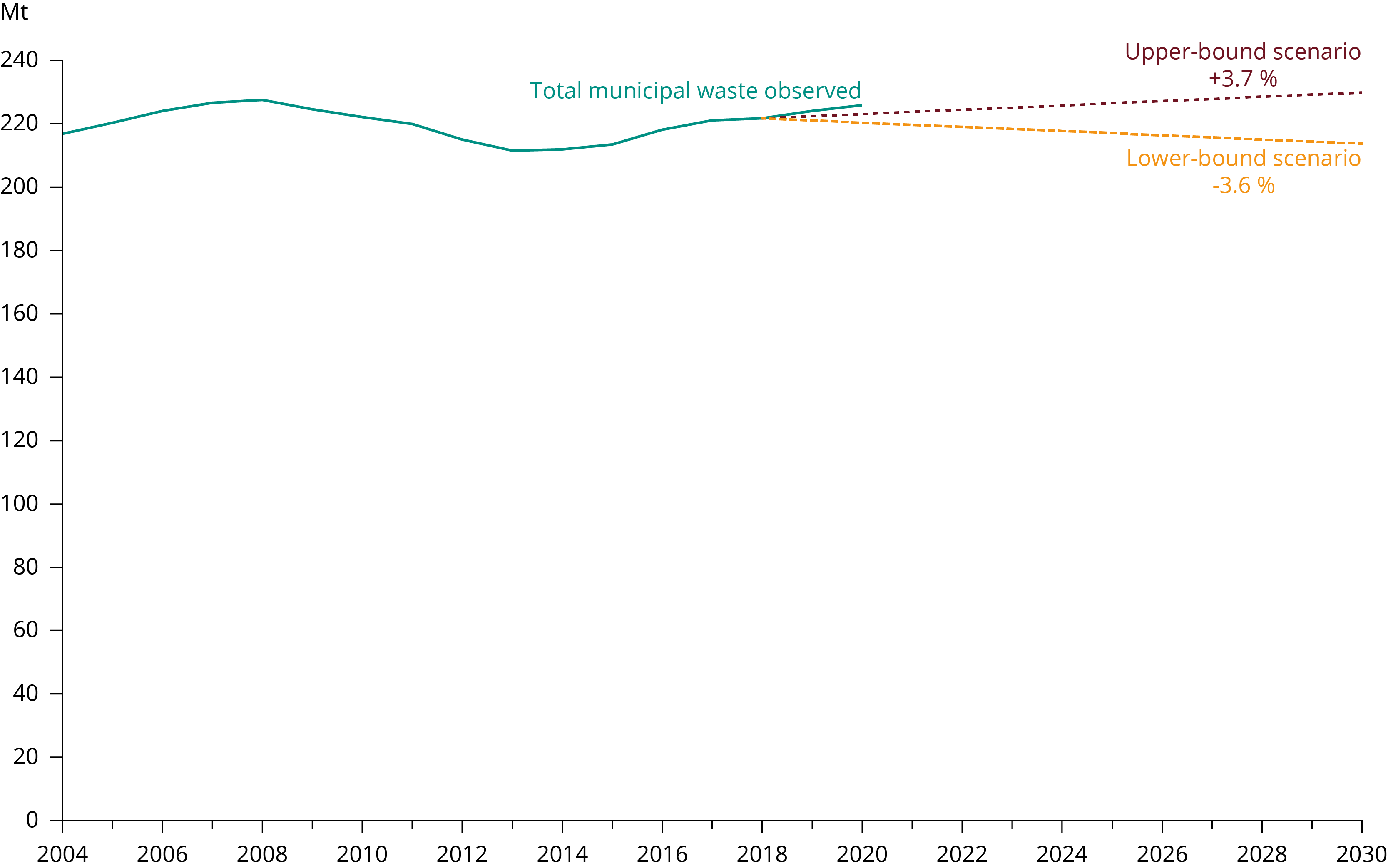
Notes: The projection of a 3.7% increase is based on the amount of waste per capita (1996-2018) and Eurostat population projections, and considers the differences in waste generation among the EU Member States. The projection of a 3.6% decrease considers a linear trend using total municipal waste data from 2004 to 2018. Neither projection takes into account the latest available data (2019/2020).
Source: EEA calculation based on Eurostat (2022b) and the scenarios for total municipal waste generated in 2030 (European Commission et al., 2022).
More info...
How can both municipal waste targets be achieved?
Considering the upper-bound scenario, which projects an increase in municipal waste, and assuming that all EU Member States will achieve, but do not exceed the recycling target of 60%, the amount of residual municipal waste would still be around 87 million tonnes in 2030. This would mean missing the target amount (56.5 million tonnes) by more than half.
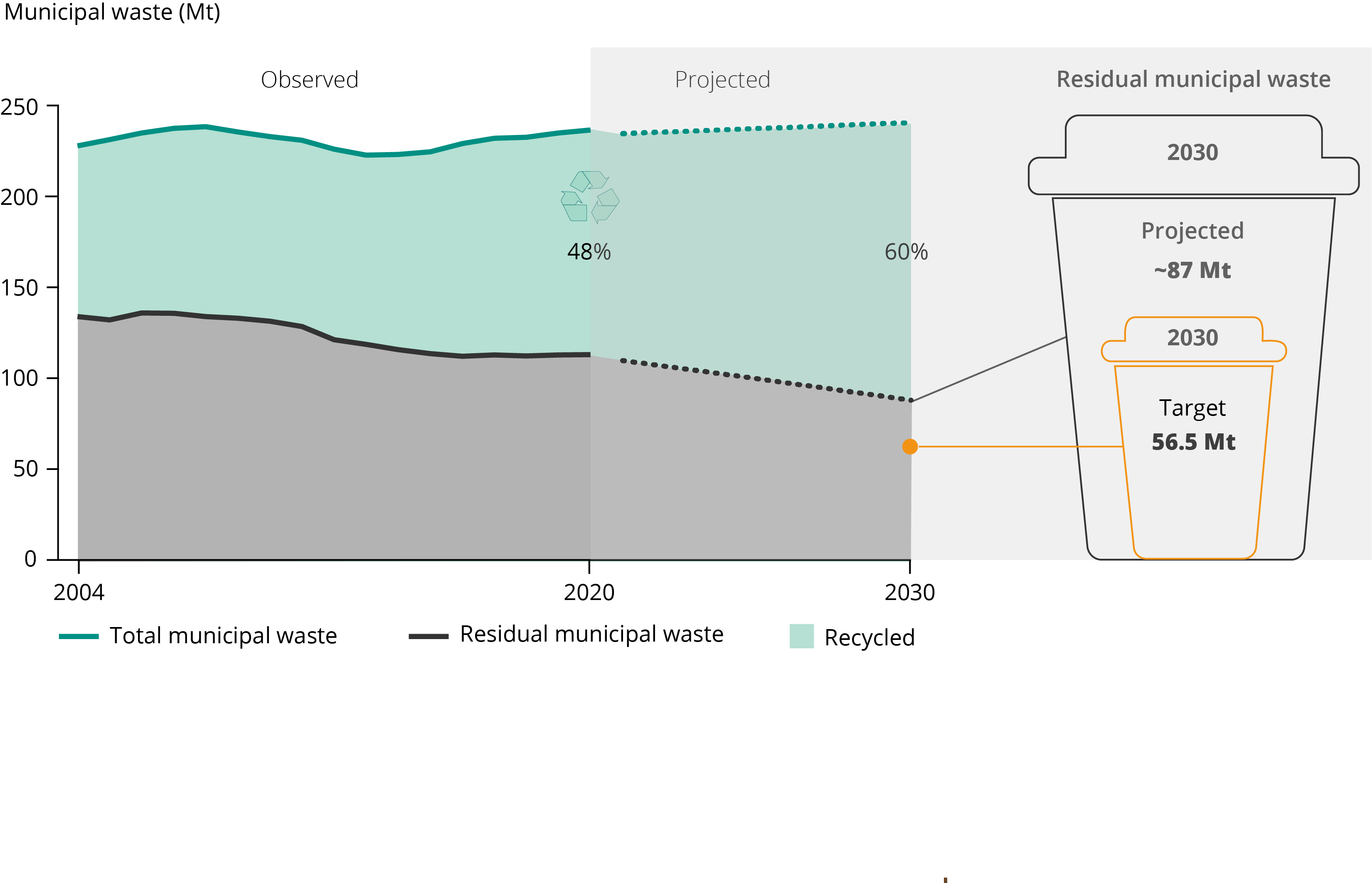
Source: EEA calculation based on Eurostat (2022b) and the scenarios for total municipal waste generated in 2030 (European Commission et al., 2022).
More info...
Even if the lower-bound projection for municipal waste (decrease of 3.6%) is considered, meeting the 60% recycling rate target would still not be enough to meet the residual waste target. In fact, 81 million tonnes of residual waste would still be generated under this scenario, exceeding the residual waste target by 44%.
Prioritising waste prevention to reach municipal waste goals
These projections clearly indicate that the target of halving residual municipal waste by 2030 is unlikely to be achieved without reducing waste generation.
Without waste prevention, the average EU recycling rate would have to increase to 72% or 73% to meet the target for residual waste by 2030, depending on the scenario for future municipal waste generation (Figure 5). Such recycling rates are far above the current 48% rate and considerably higher than even the 65% recycling target for 2035 set in the Waste Framework Directive. As many EU Member States are already struggling to meet targets set for 2020 and 2025, reaching these recycling rates is unlikely. Such high recycling rates are unprecedented and would require a significant improvement in separate collection systems and recycling infrastructure, underpinned by a widespread redesign of products to make them more recyclable. The low-hanging fruits of recycling have already been picked, so such an increase in recycling would be likely to require considerable investment and could lead to low-quality recycling. Clearly, preventing the generation of waste that is difficult to recycle or not recyclable must be a priority.
However, it would be possible to meet the target of halving residual municipal waste with a 60% recycling rate if the generation of municipal waste was reduced by one third, as shown in Figure 6. This could be achieved through substantially stepping up the EU’s and Member State’s efforts on waste prevention.
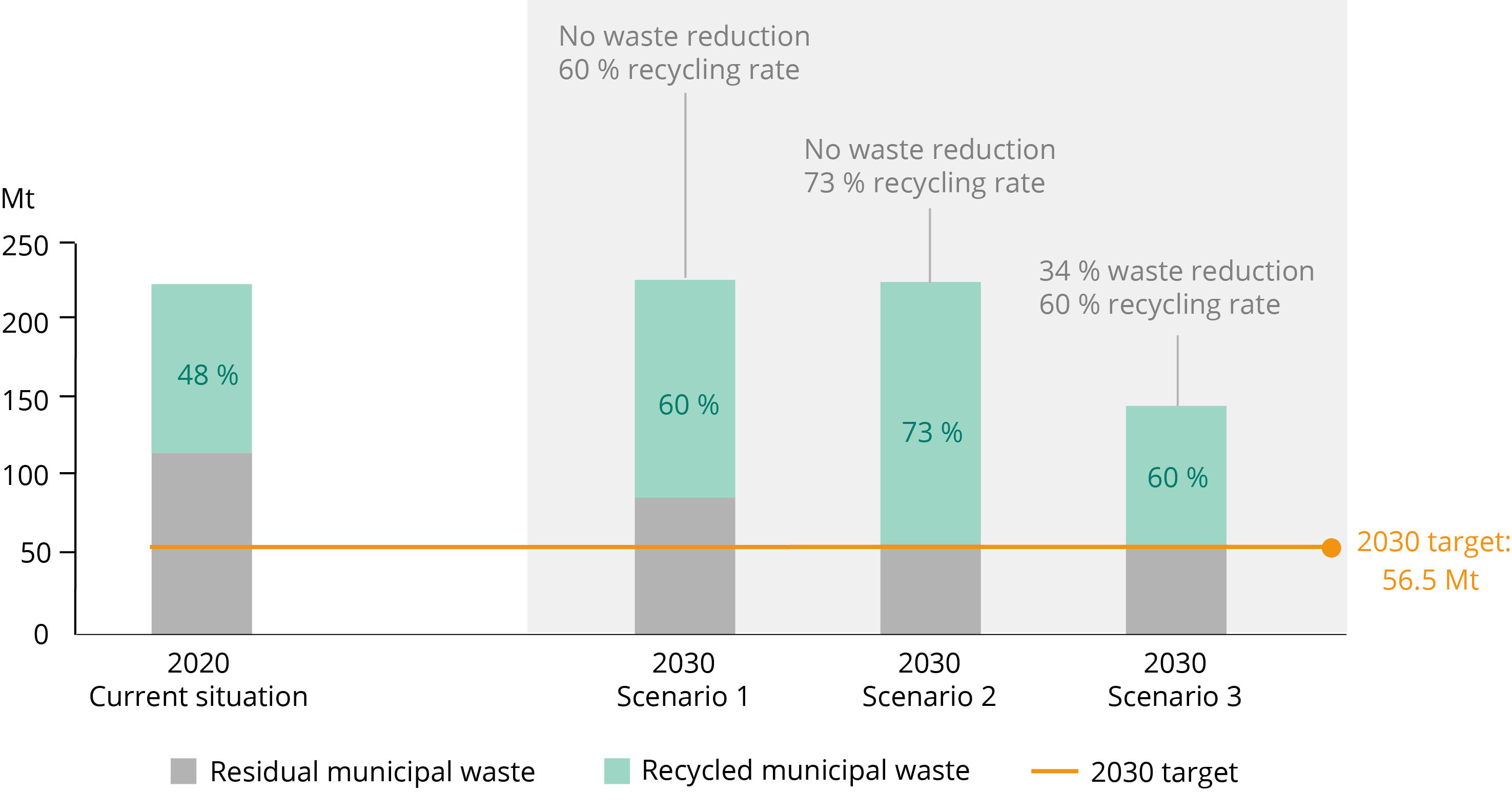
Notes: Future scenarios: (1) 3.7% increase in total municipal waste generated (i.e. no waste reduction or ‘business as usual’ (BAU)) and 2030 recycling target of 60% met; (2) 3.7% increase in total municipal waste generated (i.e. no waste reduction) with 73% recycling rate; and (3) reduction in total municipal waste of 34% compared with the scenarios 1 and 2 and 60% recycling target met.
Source: EEA calculation based on Eurostat (2022b) and the scenarios for total municipal waste generated in 2030 (European Commission et al., 2022).
More info...
Therefore, to achieve the residual municipal waste target, the EU and the Member States can further stimulate recycling through the implementation of the waste directives. Alternatively, strong waste prevention policies targeting municipal waste could be applied. These are not the only options, but represent the two extreme cases, and a combination of increased recycling and more intense prevention efforts could also be used to reach the target (Figure 7). In fact, experiences in several municipalities have shown that it is possible to achieve high recycling rates (above 60%) while also increasing waste prevention (Zero Waste Europe, 2021).
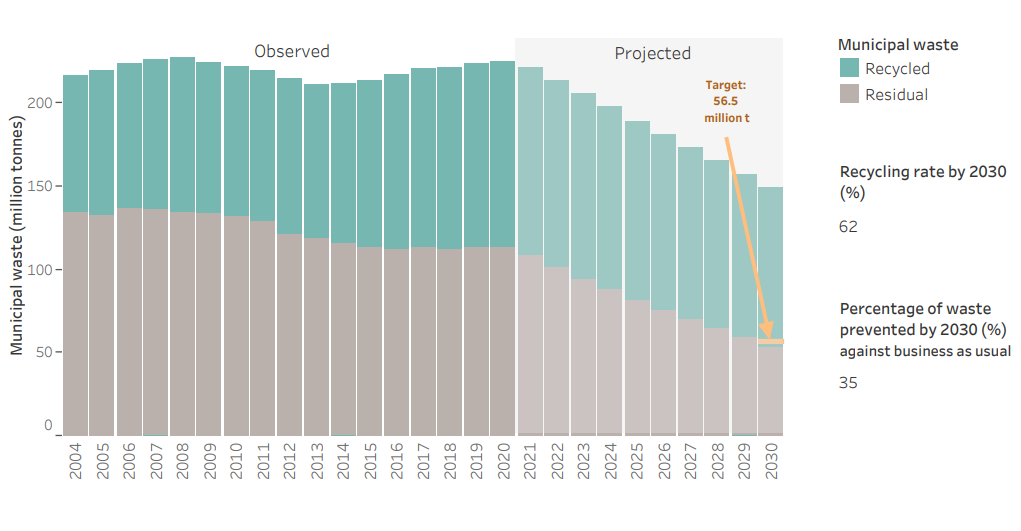
Note: The figure shows the generation of recycled and residual municipal waste in 2030 depending on the recycling rate and the percentage of waste prevented by 2030 compared to the business as usual scenario, as chosen by the user. A linear trajectory is assumed between 2020 and 2030.
Source: EEA calculation based on Eurostat (2022b) and the scenarios for the total municipal waste generated in 2030 (European Commission et al., 2022).
More info...
Prioritising prevention in the policy mix has clear environmental benefits — hence the position of prevention at the top of the EU’s waste hierarchy. Preventing waste not only uses fewer materials, thus improving resource efficiency, but also reduces the operational costs associated with waste management and is more beneficial for the environment and climate than recycling.
Waste prevention has been a long-standing goal of EU waste policies, and all EU Member States have had to develop and regularly update waste prevention programmes since 2013. However, there has been no direct or measurable effect of the wide adoption of waste prevention programmes on the EU level, as the amounts of municipal waste generated have actually increased (EEA, 2021). Based on these observations, an ambition to reduce the generation of municipal waste by one third in the next decade would require EU Member States to immediately rethink their waste prevention policies and implement far-reaching measures targeting a wide range of prevention aspects, from the design of products to the promotion of reuse.
However, there are indications that stronger waste prevention policies will be implemented in the future. The countries with recently revised programmes have to some extent shifted focus from predominantly information-based instruments (such as awareness-raising campaigns and knowledge-sharing opportunities) towards regulatory or economic measures, which should increase the effectiveness of prevention soon (EEA, 2021).
In addition, at the EU level, several of the actions and measures in the circular economy action plan adopted in 2020 (EC, 2020) are expected to support the prevention of municipal waste. The sustainable products initiative, the ‘right to repair’ initiative, strategies on key value chains and the European Commission’s commitment to propose waste prevention targets for specific waste streams, including food waste, are some of the most relevant. However, although binding targets have shown success in driving better waste management, currently none exists for waste prevention at the EU level (EEA, 2019).
It is clear that much stronger measures and effective implementation actions are required to meet the target of halving the amount of residual municipal waste by 2030. Such actions must aim to achieve a substantial reduction in waste generated in the EU and could include binding targets for waste prevention, thereby shifting the focus to the top of the waste hierarchy and addressing waste generation at source.
Notes
[1] The reference year is not defined in the circular economy action plan; 2020 was selected, since it corresponds to the year in which the plan was adopted and it is the latest year for which data are available.
References
EC, 2019, Communication from the Commission to the European Parliament, the Council, the Economic and Social Committee and the Committee of the Regions —The European Green Deal (COM/2019/640 final).
EC, 2020, Communication from the Commission to the European Parliament, the Council, the Economic and Social Committee and the Committee of the Regions — A new circular economy action plan for a cleaner and more competitive Europe (COM(2020) 98 final of 11 March 2020).
European Commission, Directorate-General for Environment, Karigl, B., Neubauer, C., Kral, U., et al., 2022, Scoping study to assess the feasibility of further EU measures on waste prevention : final report, https://data.europa.eu/doi/10.2779/21588
EEA, 2019, The European environment — state and outlook 2020,European Environment Agency.
EEA, 2021, Progressing towards waste prevention in Europe — the case of textile waste prevention, EEA Report No 15/2021, European Environment Agency.
EU, 2018, Directive (EU) 2018/851 of the European Parliament and of the Council of 30 May 2018 amending Directive 2008/98/EC on waste (OJ L 150, 14.06.2018, p. 109-140).
Eurostat, 2022a, ‘Generation of waste by waste category, hazardousness and NACE Rev. 2 activity’, ENV_WASGEN.
Eurostat, 2022b, ‘Municipal waste by waste management operations’, ENV_WASMUN.
Zero Waste Europe, 2021, The state of zero waste municipalities report 2021, Zero Waste Europe.
Identifiers
Briefing no. 02/2022
Title: Reaching 2030’s residual municipal waste target — why recycling is not enough
EN HTML: TH-AM-22-002-EN-Q - ISBN: 978-92-9480-458-7 - ISSN: 2467-3196 - Doi: 10.2800/74110
EN PDF: TH-AM-22-002-EN-N - ISBN: 978-92-9480-457-0 - ISSN: 2467-3196 - Doi: 10.2800/402696




Document Actions
Share with others